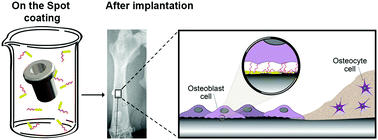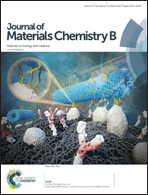Peptide coating applied on the spot improves osseointegration of titanium implants†
Abstract
The border between an implant's foreign material and the host tissue poses the most challenging conditions for tissue healing. With proper knowledge of the surface properties of the implant many of the side effects experienced following implantation could be eliminated by specifically designed functional coatings. We have recently demonstrated the design of a bifunctional peptide, composed of a β-strand decorated by two pSer residues that adsorb strongly on the oxide surface layer of titanium (TiO2), followed by a Glu-rich ‘tail’ that induces calcified mineralization. Based on kinetic analysis, we show here that such a peptide is readily adsorbed from solution, on the spot, within minutes, on the surface of titanium implants. Peptide coated surfaces exhibit a larger area of focal adhesion points, compared to uncoated TiO2. In the model blood serum the peptide coated implants were found to adsorb cell adhesion proteins. The efficacy of peptide coated titanium alloy (Ti6Al4V) implants was tested in a rabbit femur bone model. Histology and micro-computerized tomography (μCT) analysis of the removed femora showed a higher bone density and improved bone-implant osseointegration compared to uncoated implants.



 Please wait while we load your content...
Please wait while we load your content...